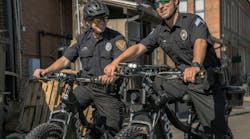When Soon Kim, a Korean national working at Bryce Canyon National Park in Utah, disappeared during a boating trip on Lake Powell with his roommate in 1985, the subsequent investigation turned up more questions than answers — about both his life and death.
The roommate told authorities that Kim had been thrown out of their boat when it bounced over the wake of another boat, recounts Brian O'Dea, special agent for the National Park Service (NPS) in Glen Canyon National Recreation Area (NRA). But the body was never found.
Drownings are not uncommon on Lake Powell, which averages more than one a month, and neither are missing bodies. Many parts of the sprawling lake are extremely deep, more than 500 feet, and bodies can sink to the bottom or get caught between temperature zones, becoming suspended in the water for long periods of time, then later floating back to the surface.
Details of the missing man's life, however, raised eyebrows among NPS law enforcement officials, prompting them to take a close look at the case. The roommate reported Kim always had lots of cash, and the emergency contact listed on his employment application was for a person who claimed to have never heard of Kim. A check of records at the university the missing man claimed to have graduated from listed no one by the name of Soon Kim.
"There was speculation that he may have been involved in crime or been hiding out from someone," says Lex Newcomb, GIS coordinator, Paleontology Program manager and crime scene mapper for the NPS in Glen Canyon NRA. Part of the investigation showed Kim had moved around from lodge to lodge and stored money in several locations. It was also revealed that Kim had used many aliases and was in possession of several different ID cards.
The lies he told in life only made his disappearance that much more intriguing. But with no body recovered, the case eventually faded from memory — until May 2005. That's when hikers enjoying a day on Lake Powell's shores made a gruesome discovery. They found bones with remnants of flesh and tatters of clothing scattered just above the water line in an area of the lake that had been exposed only recently due to falling water levels caused by a multi-year drought in Colorado.
NPS law enforcement officials and local county officers arrived at the scene that same day. Very quickly they realized two things. First, the remains could be those of the Korean national missing for 20 years or possibly those of one of two other people reported missing in the same area. And second, the site where the body parts rested — a potential crime scene — would become submerged again, perhaps within hours, due to the spring runoff into Lake Powell.
"The water level can rise more than a foot a day during the spring," says Newcomb. Officials decided to use GIS and recently-purchased photo mapping software called GPS-Photo Link from GeoSpatial Experts of Thornton, Colorado. This package would allow them to quickly map the locations of body parts and personal effects for use later in the investigation, if needed.
The mystery deepensThe Park Service operates a sophisticated GIS at the Glen Canyon NRA headquarters in Page, Arizona, and uses the system for crime scene analysis and mapping. Although typically called into service for more traditional applications, the Glen Canyon NRA was one of the first to successfully use crime scene mapping and analysis in court.
From line-of-site analysis to the tracking of kidnappers and cop killers, the GIS system — developed with software from ESRI Inc. of Redlands, California — has been used extensively to bring criminals to justice and help investigators solve crimes and mysteries alike. It contains numerous data layers, including satellite imagery and aerial photography, covering several NPS properties in southern Utah and northern Arizona.
"GIS is used in all aspects of park management from environmental impact studies and natural resource mapping to construction planning, survey and law enforcement," Newcomb says. "We completed a bathymetric mapping of the entire Lake Powell at 10-foot contours for enhanced lake operations."
Newcomb explains mapping the subsurface topography of the lake became critical several years earlier as the water level continued to drop due to drought in the Colorado River area, which feeds the lake. It became important for marina and ferry operators to know what lay below the water near their facilities. They had to plan ahead for the falling water levels to make sure they had sufficient depth to operate in. It is also used to navigate, project yearly beach acreages, and in search and recovery efforts.
When the body was found in May 2005, officials checked a list of missing persons and concluded the remains were probably one of three apparent drowning victims, never accounted for. Fortunately, extensive notes had been taken at the time, including a detailed description of the shirt Kim was wearing the day of his reported drowning. The description matched the fabric found wrapped around the bones at the scene.
"We used the GIS to cross reference the location of the body with the approximate location of where he was reported missing 20 years ago, and they were very close," says Newcomb. "Analysis of the GIS revealed the area where Kim was found was about 100 feet underwater in 1985."
But in 2005, authorities still weren't sure if Kim had drowned by accident or by foul play. They realized the answers might be found at the site, and clues may even be deciphered by the layout of the crime scene itself. According to O'Dea, officials didn't know if the coroner was going to discover that Kim had died from a blow to the head or something else. The officials on site felt they had to preserve the site if it indeed turned out to be a crime scene.
O'Dea explains that when bones and clothing are spread out over a large area, the pattern of dispersal can tell a forensics expert quite a bit about what may have happened. For example, the layout of the bones on the ground could reveal whether the body had been dismembered elsewhere and dumped there. Or the scene could help officials simply reach the conclusion that wave action or even coyotes had spread the items out over time.
With the water rising by the hour, however, officials lacked the time to perform as much investigation on site as they would have liked. They called on Newcomb to bring in a digital photographic mapping technique he had recently introduced to the NPS GIS laboratory. In less than an hour, he would be able to photographically map the entire 3-acre site.
Photo mapping the sceneNewcomb had recently purchased a Ricoh G3 digital camera equipped with a GPS card for use with the GPS-Photo Link. Although Newcomb uses real-time GPS equipment for cases like this, the GPS card provides sufficient location accuracy for projects where sub-meter accuracy is not necessary. The software correlates the precise locations where the photos were taken with their locations on the Glen Canyon GIS. Once on the site, he began snapping photos of each exposed body part, piece of clothing, or other evidence in a sequence recommended by the investigators. With each photo, the GPS card recorded the precise location with a time stamp of critical evidence.
"It took me an hour to take the pictures and then just a few minutes to upload the photos from the camera into the photo-mapping software running inside our GIS back in Page," says Newcomb.
The photo-mapping software automatically correlated the photos by GPS location and stamped each with coordinates, and time and date of collection. Newcomb was able to add a title to each frame as necessary. The photo-mapping package then georeferenced the photos to their locations on the GIS base map, denoting each body part and personal effect with an icon on the digital map. This created a spatially accurate map of evidence locations. Newcomb or an investigator could simply click on any icon on the GIS screen to view the actual photograph and read any notes entered into the system.
Viewed in its entirety, the map of evidence suggested the body had simply been broken apart by wave action and possibly coyotes over years as the water became shallower over the site, according to O'Dea. The coroner found no evidence of trauma to the body, although it was too decomposed to tell for sure. To this day, no one really knows what happened to Kim.
A new investigative toolWith no hard evidence of a crime, the mysterious case of the life and death of Soon Kim was closed. But O'Dea says some good came out of the investigation. Specifically, he believes the use of GIS and GPS photo-mapping technology could emerge as very useful tools for law enforcement officials who need to preserve a crime scene.
O'Dea believes GPS photo mapping is an excellent tool for investigators to use in spatially piecing together clues that are spread out over large areas. Certain types of crime scenes, such as assaults or rapes or even high-speed chases, often span large areas and leave behind a trail of evidence such as weapons, blood or bullet casings, that can be mapped and analyzed using this technology.
Kevin Corbley is a consultant specializing in geospatial technologies. He may be reached at www.corbleycomunications.com.


